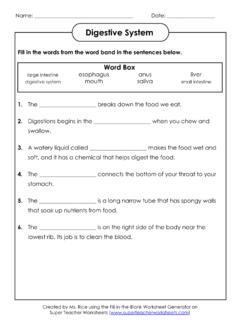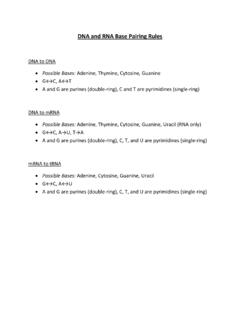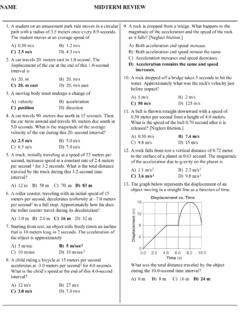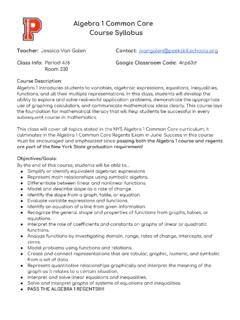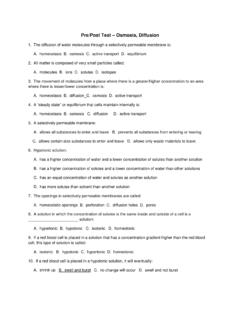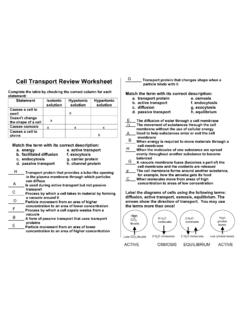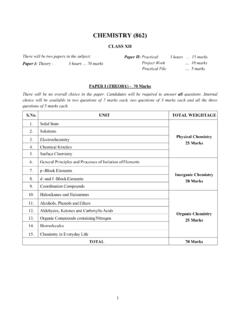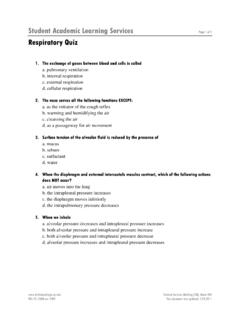Transcription of What You Absolutely Need to Know To Pass the NYS Living ...
1 Index of Living Environment Units Unit 1: Science and the Living Environment (pg 2-4) Scientific method Controlled experiments Graphing Characteristics of good experiment Unit 2: Characteristics of Living Things (pg 5-10) Chemistry (carbohydrates, lipids, proteins, enzymes, acids and bases) Homeostasis, metabolism, and life processes (including photosynthesis and respiration) Cells Unit 3: Homeostasis and the Human Body (pg 11-15) Organization Human body systems Diseases and disorders Unit 4: Reproduction (pg 16-17) Mitosis and meiosis Asexual and sexual reproduction Human reproduction and development Unit 5: Genetics (pg 18-20) Genetic code and protein synthesis Genetic technology Unit 6: Evolution (pg 21-23) Natural selection Speciation Gradualism vs Punctuated Equilibrium Evidence for evolution Classification Unit 7.
2 Ecology (pg 24-26) Interactions between organisms Food chains and food webs Biodiversity Human impact on the environment Appendix: State Labs (pg 27-28) Making Connections (Clothespin Lab) Relationships and Biodiversity (Botana curus lab) Beaks of Finches diffusion Through a Membrane What You Absolutely Need to Know To Pass the NYS Living Environment Regents Exam The LE Exam consists of approximately 75 questions worth a total of 85 points. The exam is broken down into 4 parts: Part A: General knowledge multiple choice questions (30 points) Part B: A mix of multiple choice and short answer, dealing with the application of knowledge.
3 So far, Part B has always required students to draw a line graph. (25 points) Part C: Short answer questions dealing with your ability to apply material learned in the course to real world situations. (15 points) Part D: Multiple choice and short answer, pertaining to the 4 NYS labs performed during the school year. (15 points) The state requires all answers to be recorded in such a way that they can not be tampered with. As such, all answers on the test must be written in permanent pen, and mistakes may not be scribbled out.
4 2 of 28 UNIT ONE: Science and the Living Environment A. Terms: 1. Observation: What is seen or measured. 2. Inference: A conclusion based on observation or evidence. 3. Hypothesis: A prediction based on available evidence. A good hypothesis states both cause and effect. a. A correct hypothesis can be tested and falsified (proven incorrect) using an experiment. b. The easiest way to write a correct hypothesis is as an if-then statement. (ex: If I give patients this pill, then they will not get sick.)
5 4. Theory: An explanation of natural events that is supported by strong evidence. a. Theories tie together many scientific facts, hypotheses and laws. b. Misconception: Theories are things that are opinions, or are not proven. This is an incorrect use of the word theory in a scientific context. A scientific theory is not a simple guess or conjecture, and is strongly supported by evidence. B. Controlled Experiment: Compares the results of an experiment between two (or more) groups. 1. Experimental group: Group being tested or receiving treatment.
6 2. Control group: Normal group. Should be identical to experimental group in every way except one: it does not receive the new treatment. 3. Placebo: A sugar pill or other fake treatment given to the control group. 4. Independent Variable: Variable that is being tested (ex: new drug, new fertilizer). a. The If part of an If-then hypothesis. b. The independent variable is always plotted on the X axis. 5. Dependent Variable: Variable that is measured at the end of an experiment; the results.
7 A. The then part of an If-then hypothesis. b. The dependent variable is always plotted on the Y axis. 3 of 28 C. Graphs and Data Tables 1. Data tables are used to organize data which will be plotted in a graph. a. First column in the table is for the independent variable. b. Second column is another for the dependent variable. c. Each column should be titled, and include units of measurement. d. Data in the table must be arranged in ascending or descending order. 2.
8 Both the x and y axis of the graph must be labeled or titled. These labels are typically the same ones used in the data table. Once again units of measurement must be written with the title. 3. The independent variable is always plotted on the x-axis. 4. The dependent variable is always plotted on the y-axis. 5. The x and y axis must be numbered. a. These numbers must increase by a uniform increment (that is you must count by 1 s, 2 s, 5 s, 10 s, etc). b. Your numerical scales should take up most of the axes.
9 Squeezing it all into the bottom corner makes the graph impossible to read and no credit will be given. c. The numbers must line up with the grid lines of the graph, not with spaces between them. d. You do not need to start numbering your axis with 0. 6. To date, all graphs drawn on the LE Regents have been line graphs. Any student who draws a bar graph instead of a line graph will be denied credit for this part of the test. 7. All points plotted on your graph must be surrounded by a circle (or sometimes a square or triangle, depending on the directions).
10 4 of 28 D. Characteristics of a good experiment: 1. Can be repeated the same way and get the same results. 2. Have large sample size/many test subjects. 3. Are performed for longer periods of time. 4. Test only one independent variable. All other characteristics of the tested groups should be the same. 5. Are peer reviewed examined by several scientists to determine its accuracy. 6. Must test the hypothesis and show whether it is wrong or right. 7. Is objective the experiment and conclusion are fair and unbiased.
